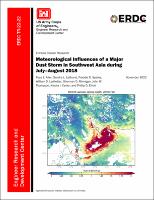Please use this identifier to cite or link to this item:
https://hdl.handle.net/11681/45960Full metadata record
| DC Field | Value | Language |
|---|---|---|
| dc.contributor.author | Alter, Ross E. | - |
| dc.contributor.author | LeGrand, Sandra L. | - |
| dc.contributor.author | Spates, Freddie D. | - |
| dc.contributor.author | Ledbetter, William D. | - |
| dc.contributor.author | Minnigan, Sherman D. | - |
| dc.contributor.author | Thompson, John W. | - |
| dc.contributor.author | Carter, Kindra I. | - |
| dc.contributor.author | Elliott, Phillip D. | - |
| dc.creator | Cold Regions Research and Engineering Laboratory (U.S.) | - |
| dc.creator | Geospatial Research Laboratory (U.S.) | - |
| dc.date.accessioned | 2022-11-09T14:31:47Z | - |
| dc.date.available | 2022-11-09T14:31:47Z | - |
| dc.date.issued | 2022-11 | - |
| dc.identifier.govdoc | ERDC TR-22-22 | - |
| dc.identifier.uri | https://hdl.handle.net/11681/45960 | - |
| dc.identifier.uri | http://dx.doi.org/10.21079/11681/45960 | - |
| dc.description | Technical Report | en_US |
| dc.description.abstract | Dust storms can be hazardous for aviation, military activities, and respiratory health and can occur on a wide variety of spatiotemporal scales with little to no warning. To properly forecast these storms, a comprehensive understanding of the meteorological dynamics that control their evolution is a prerequisite. To that end, we chose a major dust storm that occurred in Southwest Asia during July–August 2018 and conducted an observation-based analysis of the meteorological conditions that influenced the storm’s evolution. We found that the main impetus behind the dust storm was a large-scale meteorological system (i.e., a cyclone) that affected Southwest Asia. It seems that cascading effects from this system produced a smaller, near-surface warm anomaly in Mesopotamia that may have triggered the dust storm, guided its trajectory over the Arabian Peninsula, and potentially catalyzed the development of a small low-pressure system over the southeastern end of the peninsula. This low-pressure system may have contributed to some convective activity over the same region. This type of analysis may provide important information about large-scale meteorological forcings for not only this particular dust storm but also for future dust storms in Southwest Asia and other regions of the world. | en_US |
| dc.description.sponsorship | United States. Army. Corps of Engineers. | en_US |
| dc.description.tableofcontents | Abstract ................................................................................................................................................... ii Figures and Tables .................................................................................................................................. v Preface ................................................................................................................................................... vii 1 Introduction ..................................................................................................................................... 1 1.1 Background ..................................................................................................................... 1 1.2 Objective .......................................................................................................................... 2 1.3 Approach ......................................................................................................................... 2 2 Data and Methods .......................................................................................................................... 3 2.1 Study area ....................................................................................................................... 3 2.2 Data sources ................................................................................................................... 4 2.2.1 Station data ..................................................................................................................... 4 2.2.2 Satellite products ............................................................................................................ 4 2.2.3 Atmospheric reanalyses ................................................................................................. 4 2.2.4 Radiosonde data ............................................................................................................. 5 2.2.5 Precipitation data ............................................................................................................ 5 2.3 Methods .......................................................................................................................... 6 3 Description of the Dust Storm ...................................................................................................... 7 3.1 Dust-storm initiation ....................................................................................................... 7 3.2 Sweep .............................................................................................................................. 7 3.3 Spread ............................................................................................................................. 8 3.4 Spin .................................................................................................................................. 9 3.5 Drift .................................................................................................................................. 9 3.6 End of the dust storm ................................................................................................... 11 4 Synoptic-Scale Meteorological Analyses .................................................................................. 12 4.1 Timeline of events ......................................................................................................... 12 4.2 Spatial maps ................................................................................................................. 13 4.2.1 Preceding the dust storm ............................................................................................. 13 4.2.2 During the dust storm ................................................................................................... 21 4.2.3 End of the dust storm ................................................................................................... 29 4.3 Vertical cross sections .................................................................................................. 31 5 Mesoscale Meteorological Analyses ......................................................................................... 36 5.1 Precipitation .................................................................................................................. 36 5.2 Convection ..................................................................................................................... 37 6 Discussion ..................................................................................................................................... 41 7 Conclusions and Recommendations ......................................................................................... 42 References ............................................................................................................................................ 44 Abbreviations ........................................................................................................................................ 47 Report Documentation Page ..............................................................................................................48 | - |
| dc.format.extent | 58 pages / 8.5 MB | - |
| dc.format.medium | - | |
| dc.language.iso | en_US | en_US |
| dc.publisher | Engineer Research and Development Center (U.S.) | en_US |
| dc.relation.ispartofseries | Technical Report (Engineer Research and Development Center (U.S.)) ; no. ERDC TR-22-22 | - |
| dc.rights | Approved for Public Release; Distribution is Unlimited | - |
| dc.source | This Digital Resource was created in Microsoft Word and Adobe Acrobat | - |
| dc.subject | Dust storms--Middle East | en_US |
| dc.subject | Dust control | en_US |
| dc.subject | Meteorology | en_US |
| dc.subject | Weather forecasting--Mathematical models | en_US |
| dc.subject | Remote sensing | en_US |
| dc.subject | Satellites | en_US |
| dc.title | Meteorological influences of a major dust storm in Southwest Asia during July–August 2018 | en_US |
| dc.type | Report | en_US |
| Appears in Collections: | Technical Report | |
Files in This Item:
| File | Description | Size | Format | |
|---|---|---|---|---|
| ERDC TR-22-22.pdf | 8.5 MB | Adobe PDF |  View/Open |